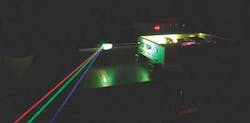FREQUENCY CONVERSION: Oscillating RGB emission forges white-light laser
Most visual colors (including white) in projection displays and other lighting applications can be obtained by a weighted combination of red, green, and blue (RGB) light. In an unusual approach to RGB color generation, scientists at Nanjing University (Nanjing, China) and Shandong University (Jinan, China) have developed a high-power RGB laser source using—for the first time—multiple frequency conversions in a diode-side-pumped Q-switched oscillating Nd:YAG laser.1
To obtain the RGB colors, the team started with an intermittent, oscillating dual-wavelength Nd:YAG laser operating at 1319 and 1064 nm. Second-harmonic generation of these two fundamental wavelengths produced the 660 nm (red) and 532 nm (green) outputs, while third-harmonic generation of the 1319 nm wavelength was used to obtain the 440 nm (blue) output. In essence, “One laser, one beam, three outputs,” according to Nanjing University researcher Xiaopeng Hu (see figure). “At any instant in time, the output alternates between green and red/blue. Because the laser operates at a high-repetition-rate (3.2 kHz), which is much smaller than the time resolution of the human eye, we can see quasi-white-light output from the instrument,” explains Hu.
In the experimental setup, the dual-wavelength Q-switched laser light with 5 W average power was focused into an optical superlattice in a lithium tantalum oxide (LiTaO3) crystal. For frequency conversion to occur, the superlattice was constructed by sandwiching together a number of individual crystal elements with appropriate phase-matching temperatures and nonlinear coefficients as a function of wavelength. The first set of crystal elements performed second-harmonic generation and third harmonic generation on the fundamental wavelength at 1319 nm of the source to produce red and blue, while a second crystal element in series with the first performed second harmonic generation on the fundamental wavelength at 1064 nm to produce the green output.
To measure the individual performance of each color output, a prism was used to separate the white-light output into its three color elements. Measurements revealed red, green, and blue output power levels of 856, 154, and 112 mW, respectively, producing an overall 1.01 W quasi-white-light output. This RGB power proportion of 9.3:1.7:1.0 is close to a cool-white point on standard chromaticity diagrams, corresponding to 118 lumens and a color temperature of about 5000 K. Variation in the total output power was measured to be about 6.5% over an hour time period; fairly stable considering that the 1319 nm and 1064 nm wavelengths varied 3.6% and 2.6%, respectively.
“Laser-based projection display (LBPD) has attracted much attention nowadays, due to the pure spectral hues, extremely large depth of focus, high brightness, high contrast, and excellent spatial resolution. The high-power all-solid-state RGB laser light source using multiwavelength QPM frequency conversion based on an optical superlattice is compact, efficient, robust and convenient, and will have potential applications in LBPD,” said Xiaopeng Hu. “Besides this, multiwavelength laser devices based on an optical superlattice will have other applications such as laser therapy, for both diagnosis and cure.”
REFERENCE
1. X. Hu et al., Optics Letters 33(4) 408 (February 2008).

Gail Overton | Senior Editor (2004-2020)
Gail has more than 30 years of engineering, marketing, product management, and editorial experience in the photonics and optical communications industry. Before joining the staff at Laser Focus World in 2004, she held many product management and product marketing roles in the fiber-optics industry, most notably at Hughes (El Segundo, CA), GTE Labs (Waltham, MA), Corning (Corning, NY), Photon Kinetics (Beaverton, OR), and Newport Corporation (Irvine, CA). During her marketing career, Gail published articles in WDM Solutions and Sensors magazine and traveled internationally to conduct product and sales training. Gail received her BS degree in physics, with an emphasis in optics, from San Diego State University in San Diego, CA in May 1986.
